MGMT 5006: Global Leadership and Change - Immelt's GE Transformation
VerifiedAdded on 2022/08/26
|16
|3933
|11
Report
AI Summary
This report delves into the leadership of Jeffrey R. Immelt during his tenure as CEO of General Electric (GE). It begins with an executive summary outlining the report's structure and key findings. The introduction defines leadership, emphasizing qualities like honesty, inspiration, and decision-making, and discusses Immelt's challenges, including economic downturns and competition. The discussion section analyzes Immelt's leadership skills, including his strategies for portfolio management, innovation, globalization, strategic focus, and organizational management. The report examines various leadership theories, such as the Great Man theory, behavioral theory, and trait theory, to assess Immelt's competencies. The report highlights Immelt's plans for GE, including his focus on organic growth, discipline, and communication with employees. Critical factors for success, such as portfolio restructuring, innovation investments, and global expansion, are also analyzed. The report concludes with a discussion of the inevitable consequences and desired goals of Immelt's leadership, emphasizing the importance of adapting to change and driving organizational growth. The information is sourced from case studies, scholarly articles, and research on Immelt's strategies. The report aims to provide a thorough understanding of leadership principles and their practical application in a complex business environment.
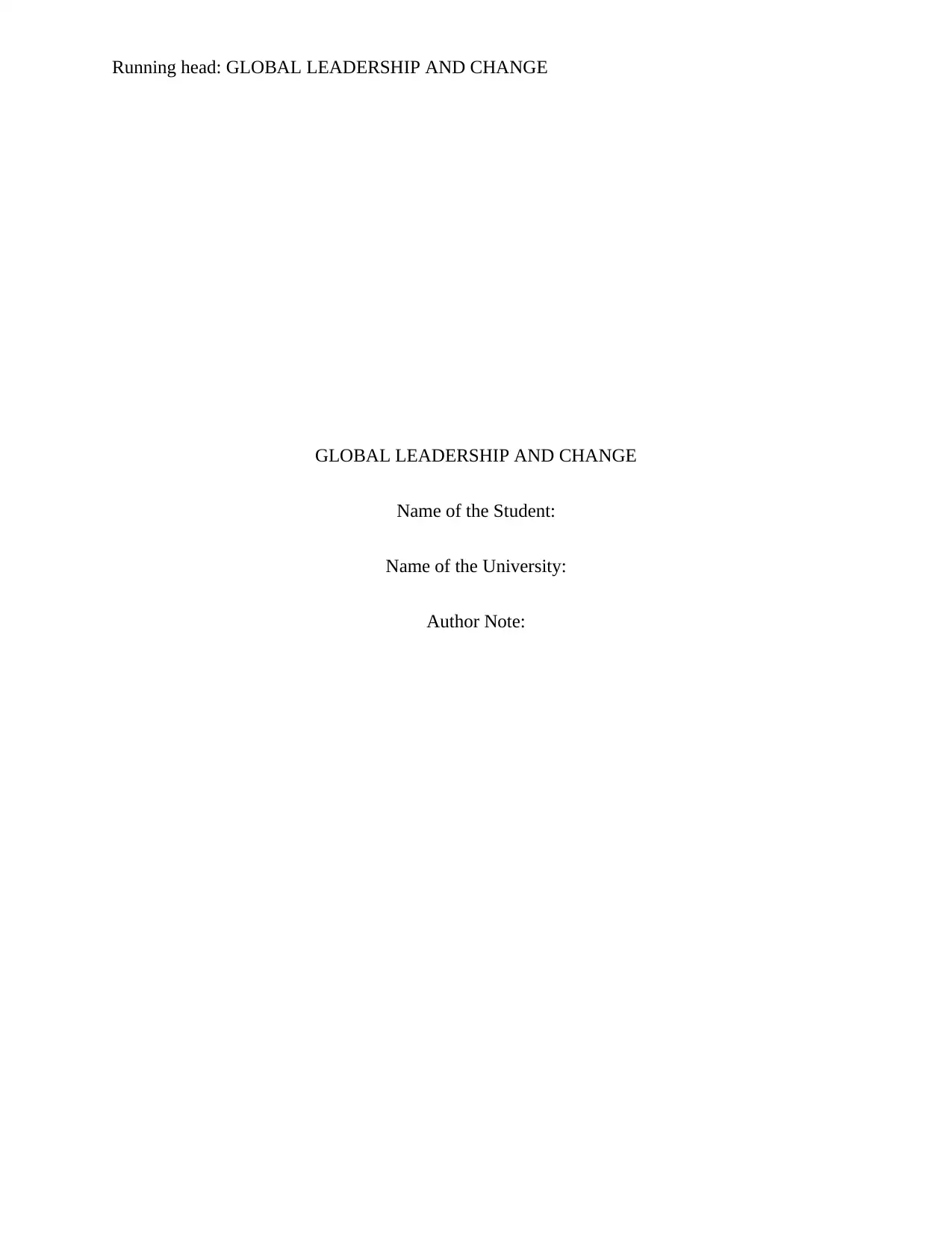
Running head: GLOBAL LEADERSHIP AND CHANGE
GLOBAL LEADERSHIP AND CHANGE
Name of the Student:
Name of the University:
Author Note:
GLOBAL LEADERSHIP AND CHANGE
Name of the Student:
Name of the University:
Author Note:
Paraphrase This Document
Need a fresh take? Get an instant paraphrase of this document with our AI Paraphraser
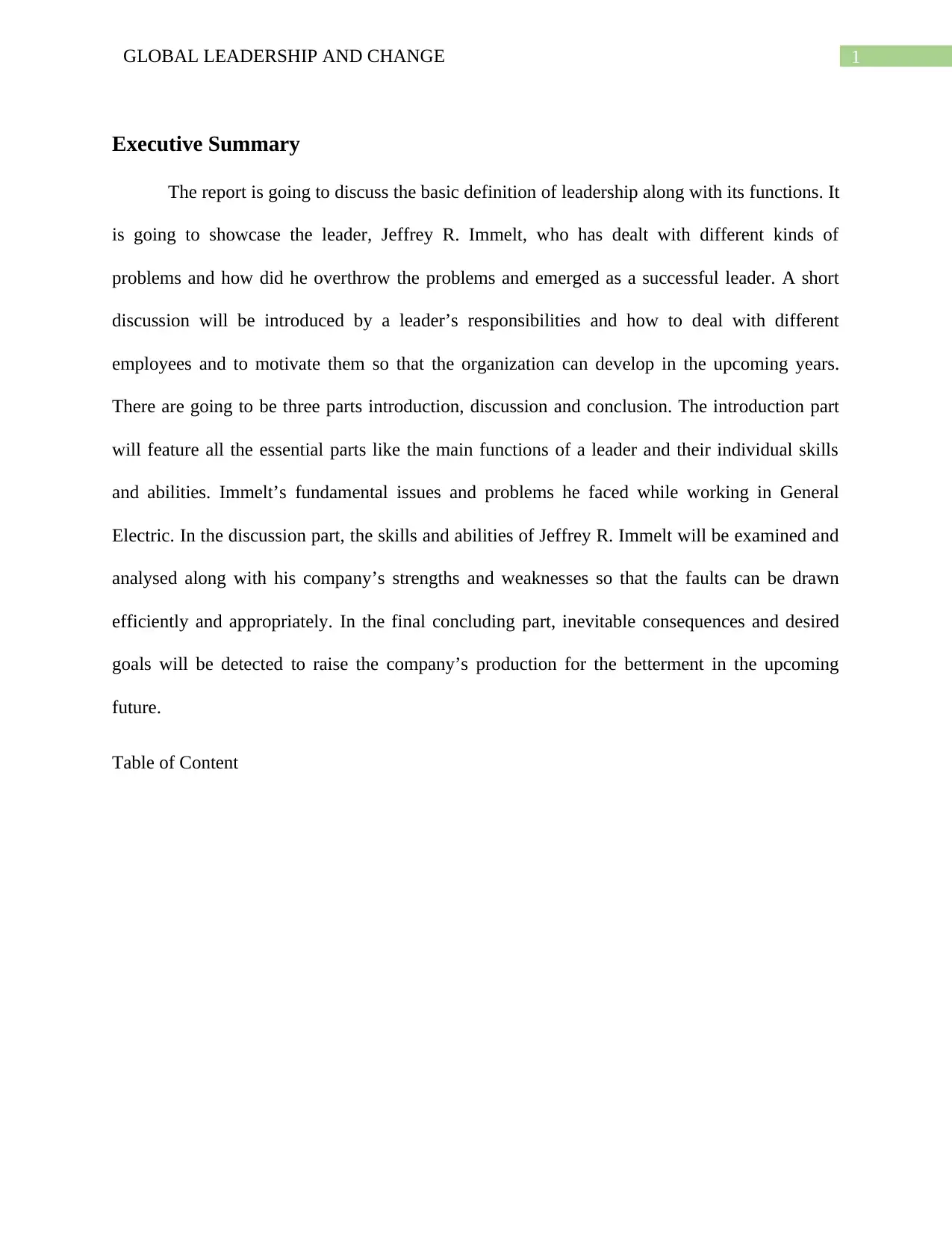
1GLOBAL LEADERSHIP AND CHANGE
Executive Summary
The report is going to discuss the basic definition of leadership along with its functions. It
is going to showcase the leader, Jeffrey R. Immelt, who has dealt with different kinds of
problems and how did he overthrow the problems and emerged as a successful leader. A short
discussion will be introduced by a leader’s responsibilities and how to deal with different
employees and to motivate them so that the organization can develop in the upcoming years.
There are going to be three parts introduction, discussion and conclusion. The introduction part
will feature all the essential parts like the main functions of a leader and their individual skills
and abilities. Immelt’s fundamental issues and problems he faced while working in General
Electric. In the discussion part, the skills and abilities of Jeffrey R. Immelt will be examined and
analysed along with his company’s strengths and weaknesses so that the faults can be drawn
efficiently and appropriately. In the final concluding part, inevitable consequences and desired
goals will be detected to raise the company’s production for the betterment in the upcoming
future.
Table of Content
Executive Summary
The report is going to discuss the basic definition of leadership along with its functions. It
is going to showcase the leader, Jeffrey R. Immelt, who has dealt with different kinds of
problems and how did he overthrow the problems and emerged as a successful leader. A short
discussion will be introduced by a leader’s responsibilities and how to deal with different
employees and to motivate them so that the organization can develop in the upcoming years.
There are going to be three parts introduction, discussion and conclusion. The introduction part
will feature all the essential parts like the main functions of a leader and their individual skills
and abilities. Immelt’s fundamental issues and problems he faced while working in General
Electric. In the discussion part, the skills and abilities of Jeffrey R. Immelt will be examined and
analysed along with his company’s strengths and weaknesses so that the faults can be drawn
efficiently and appropriately. In the final concluding part, inevitable consequences and desired
goals will be detected to raise the company’s production for the betterment in the upcoming
future.
Table of Content
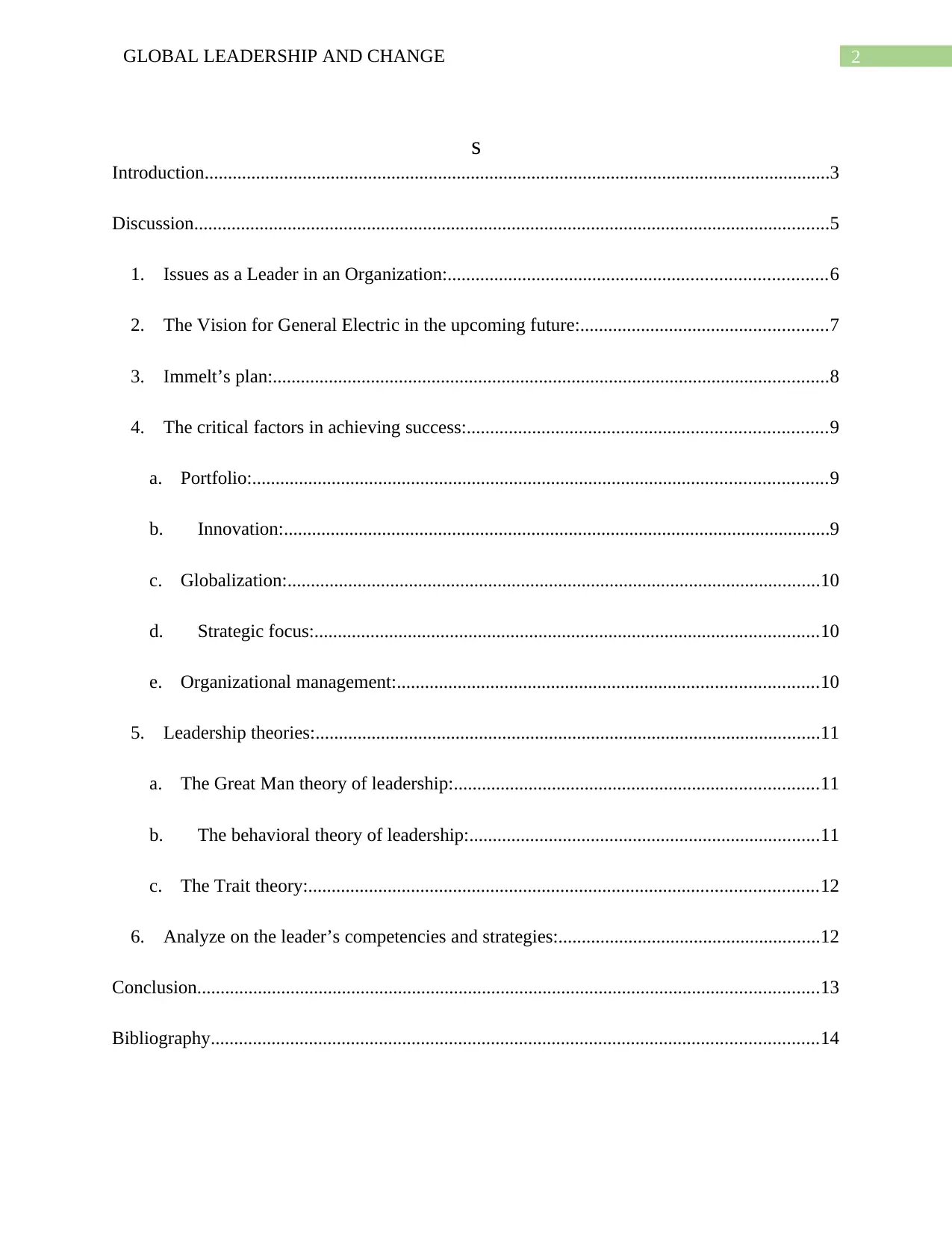
2GLOBAL LEADERSHIP AND CHANGE
s
Introduction......................................................................................................................................3
Discussion........................................................................................................................................5
1. Issues as a Leader in an Organization:.................................................................................6
2. The Vision for General Electric in the upcoming future:.....................................................7
3. Immelt’s plan:.......................................................................................................................8
4. The critical factors in achieving success:.............................................................................9
a. Portfolio:...........................................................................................................................9
b. Innovation:.....................................................................................................................9
c. Globalization:..................................................................................................................10
d. Strategic focus:............................................................................................................10
e. Organizational management:..........................................................................................10
5. Leadership theories:............................................................................................................11
a. The Great Man theory of leadership:..............................................................................11
b. The behavioral theory of leadership:...........................................................................11
c. The Trait theory:.............................................................................................................12
6. Analyze on the leader’s competencies and strategies:........................................................12
Conclusion.....................................................................................................................................13
Bibliography..................................................................................................................................14
s
Introduction......................................................................................................................................3
Discussion........................................................................................................................................5
1. Issues as a Leader in an Organization:.................................................................................6
2. The Vision for General Electric in the upcoming future:.....................................................7
3. Immelt’s plan:.......................................................................................................................8
4. The critical factors in achieving success:.............................................................................9
a. Portfolio:...........................................................................................................................9
b. Innovation:.....................................................................................................................9
c. Globalization:..................................................................................................................10
d. Strategic focus:............................................................................................................10
e. Organizational management:..........................................................................................10
5. Leadership theories:............................................................................................................11
a. The Great Man theory of leadership:..............................................................................11
b. The behavioral theory of leadership:...........................................................................11
c. The Trait theory:.............................................................................................................12
6. Analyze on the leader’s competencies and strategies:........................................................12
Conclusion.....................................................................................................................................13
Bibliography..................................................................................................................................14
⊘ This is a preview!⊘
Do you want full access?
Subscribe today to unlock all pages.

Trusted by 1+ million students worldwide
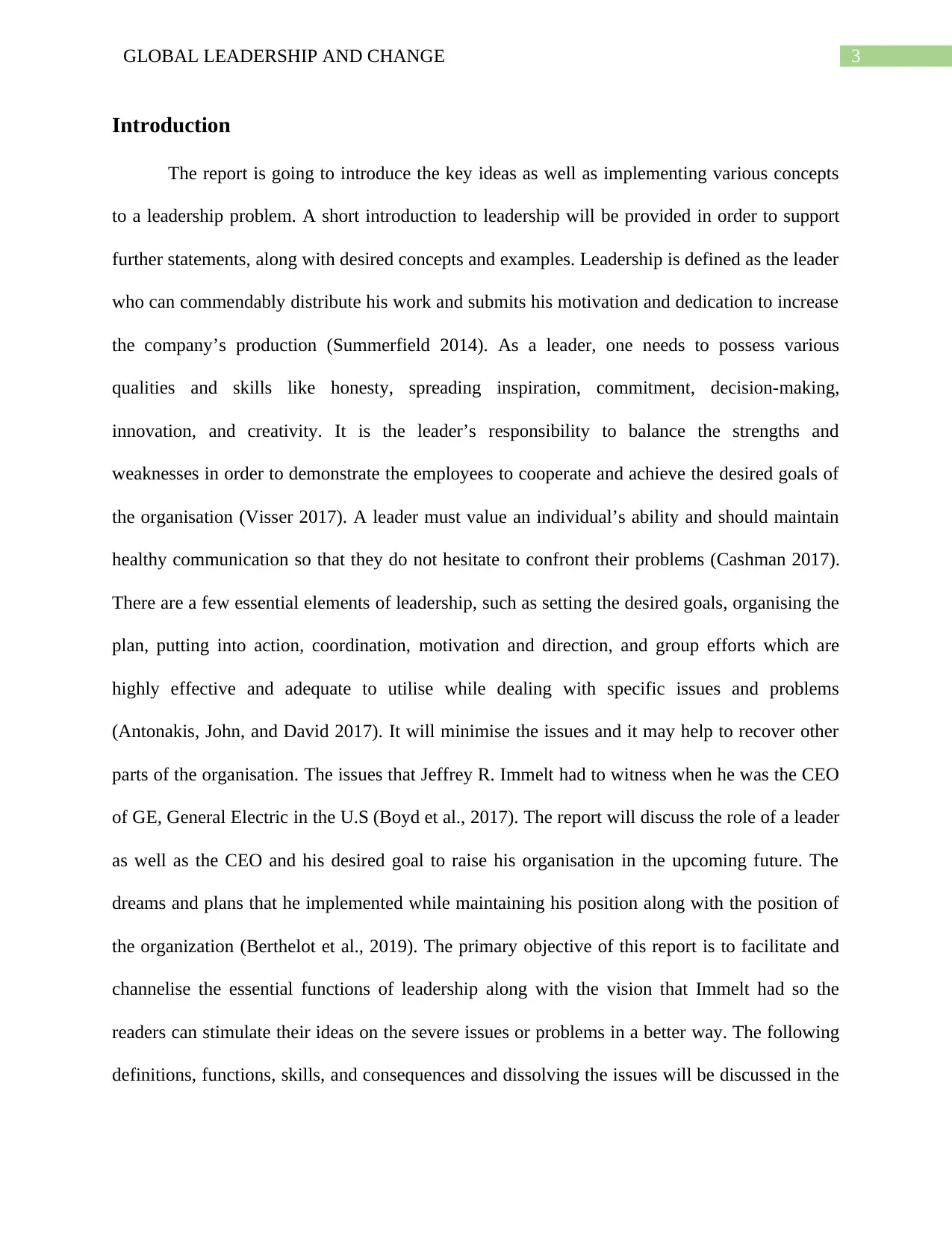
3GLOBAL LEADERSHIP AND CHANGE
Introduction
The report is going to introduce the key ideas as well as implementing various concepts
to a leadership problem. A short introduction to leadership will be provided in order to support
further statements, along with desired concepts and examples. Leadership is defined as the leader
who can commendably distribute his work and submits his motivation and dedication to increase
the company’s production (Summerfield 2014). As a leader, one needs to possess various
qualities and skills like honesty, spreading inspiration, commitment, decision-making,
innovation, and creativity. It is the leader’s responsibility to balance the strengths and
weaknesses in order to demonstrate the employees to cooperate and achieve the desired goals of
the organisation (Visser 2017). A leader must value an individual’s ability and should maintain
healthy communication so that they do not hesitate to confront their problems (Cashman 2017).
There are a few essential elements of leadership, such as setting the desired goals, organising the
plan, putting into action, coordination, motivation and direction, and group efforts which are
highly effective and adequate to utilise while dealing with specific issues and problems
(Antonakis, John, and David 2017). It will minimise the issues and it may help to recover other
parts of the organisation. The issues that Jeffrey R. Immelt had to witness when he was the CEO
of GE, General Electric in the U.S (Boyd et al., 2017). The report will discuss the role of a leader
as well as the CEO and his desired goal to raise his organisation in the upcoming future. The
dreams and plans that he implemented while maintaining his position along with the position of
the organization (Berthelot et al., 2019). The primary objective of this report is to facilitate and
channelise the essential functions of leadership along with the vision that Immelt had so the
readers can stimulate their ideas on the severe issues or problems in a better way. The following
definitions, functions, skills, and consequences and dissolving the issues will be discussed in the
Introduction
The report is going to introduce the key ideas as well as implementing various concepts
to a leadership problem. A short introduction to leadership will be provided in order to support
further statements, along with desired concepts and examples. Leadership is defined as the leader
who can commendably distribute his work and submits his motivation and dedication to increase
the company’s production (Summerfield 2014). As a leader, one needs to possess various
qualities and skills like honesty, spreading inspiration, commitment, decision-making,
innovation, and creativity. It is the leader’s responsibility to balance the strengths and
weaknesses in order to demonstrate the employees to cooperate and achieve the desired goals of
the organisation (Visser 2017). A leader must value an individual’s ability and should maintain
healthy communication so that they do not hesitate to confront their problems (Cashman 2017).
There are a few essential elements of leadership, such as setting the desired goals, organising the
plan, putting into action, coordination, motivation and direction, and group efforts which are
highly effective and adequate to utilise while dealing with specific issues and problems
(Antonakis, John, and David 2017). It will minimise the issues and it may help to recover other
parts of the organisation. The issues that Jeffrey R. Immelt had to witness when he was the CEO
of GE, General Electric in the U.S (Boyd et al., 2017). The report will discuss the role of a leader
as well as the CEO and his desired goal to raise his organisation in the upcoming future. The
dreams and plans that he implemented while maintaining his position along with the position of
the organization (Berthelot et al., 2019). The primary objective of this report is to facilitate and
channelise the essential functions of leadership along with the vision that Immelt had so the
readers can stimulate their ideas on the severe issues or problems in a better way. The following
definitions, functions, skills, and consequences and dissolving the issues will be discussed in the
Paraphrase This Document
Need a fresh take? Get an instant paraphrase of this document with our AI Paraphraser
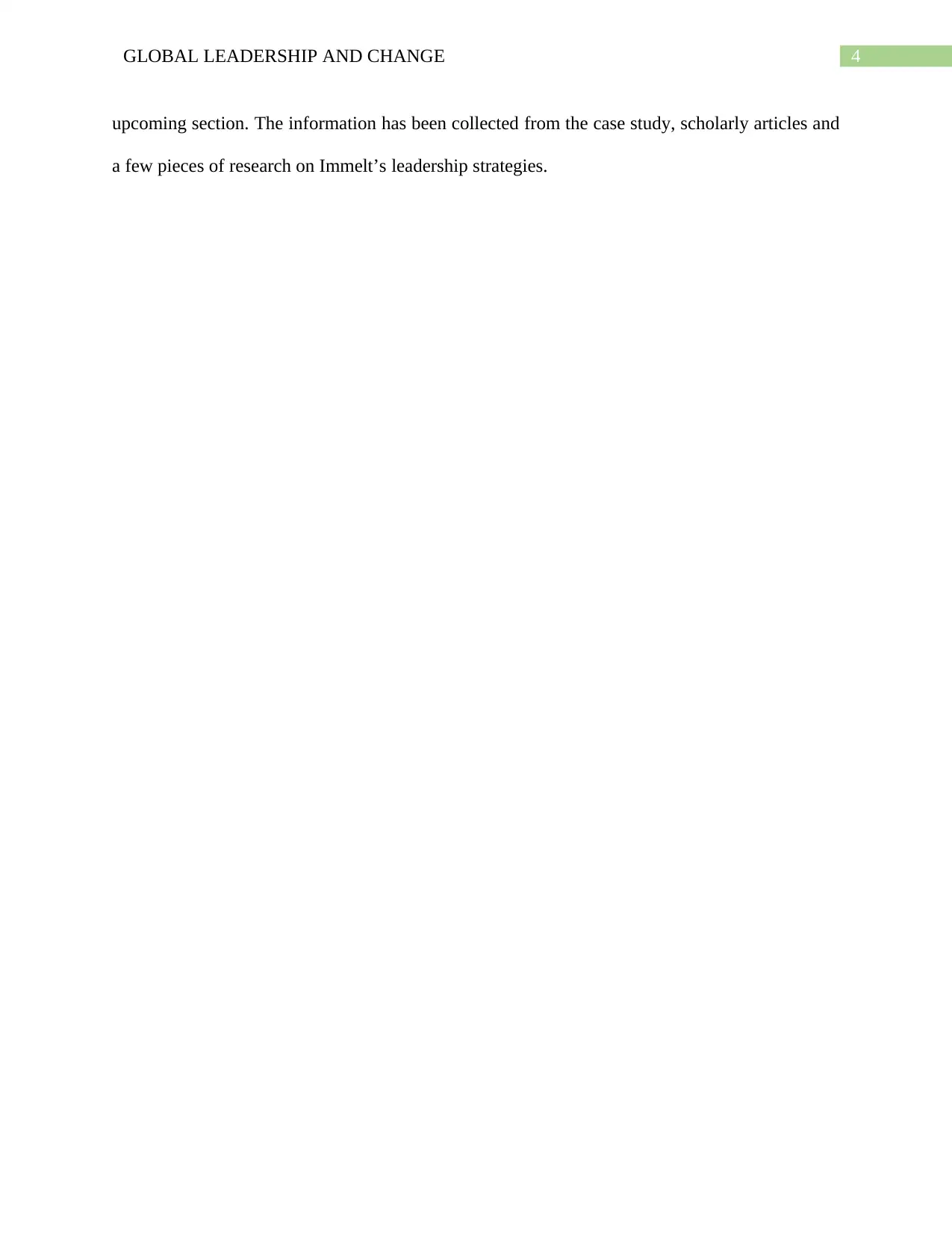
4GLOBAL LEADERSHIP AND CHANGE
upcoming section. The information has been collected from the case study, scholarly articles and
a few pieces of research on Immelt’s leadership strategies.
upcoming section. The information has been collected from the case study, scholarly articles and
a few pieces of research on Immelt’s leadership strategies.
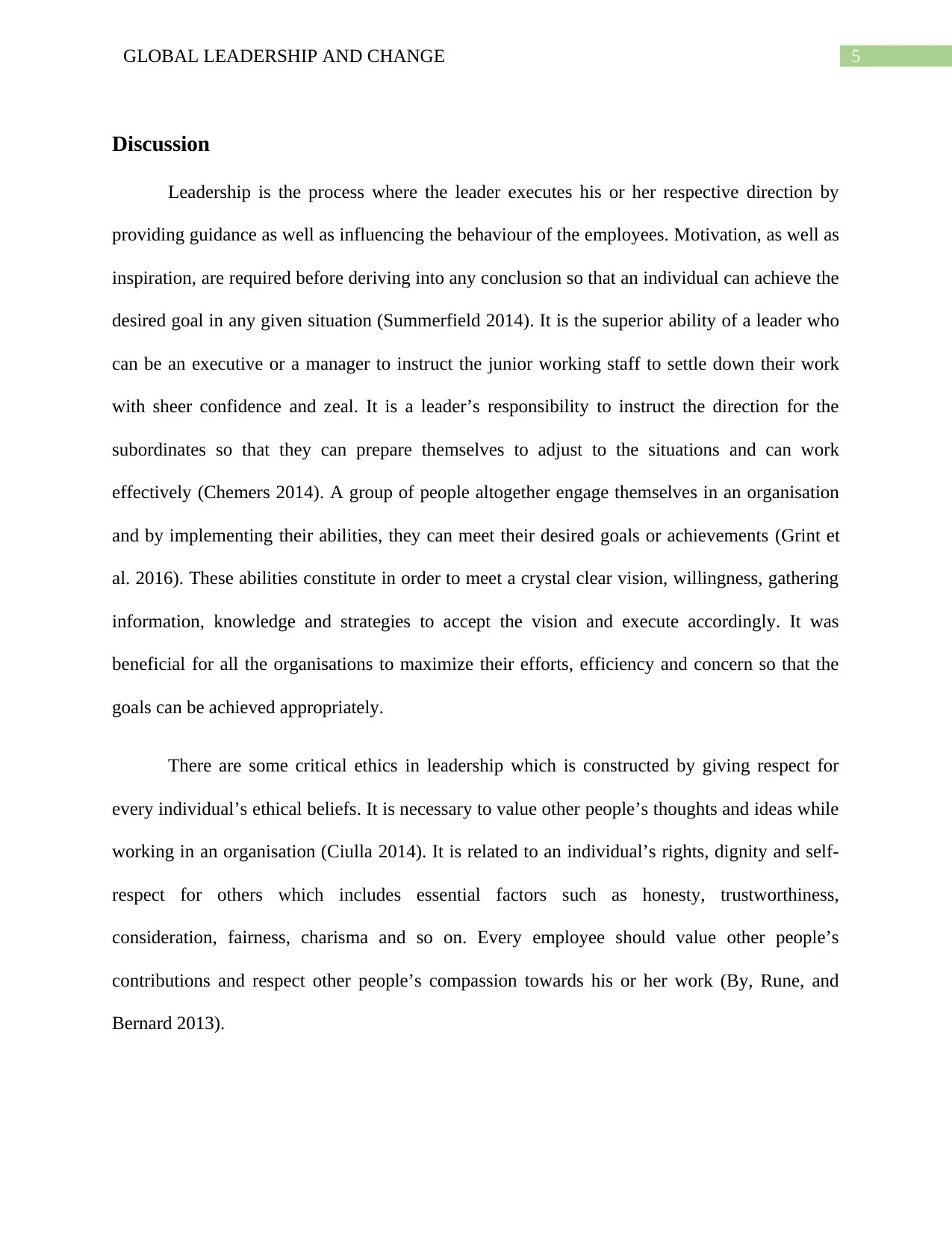
5GLOBAL LEADERSHIP AND CHANGE
Discussion
Leadership is the process where the leader executes his or her respective direction by
providing guidance as well as influencing the behaviour of the employees. Motivation, as well as
inspiration, are required before deriving into any conclusion so that an individual can achieve the
desired goal in any given situation (Summerfield 2014). It is the superior ability of a leader who
can be an executive or a manager to instruct the junior working staff to settle down their work
with sheer confidence and zeal. It is a leader’s responsibility to instruct the direction for the
subordinates so that they can prepare themselves to adjust to the situations and can work
effectively (Chemers 2014). A group of people altogether engage themselves in an organisation
and by implementing their abilities, they can meet their desired goals or achievements (Grint et
al. 2016). These abilities constitute in order to meet a crystal clear vision, willingness, gathering
information, knowledge and strategies to accept the vision and execute accordingly. It was
beneficial for all the organisations to maximize their efforts, efficiency and concern so that the
goals can be achieved appropriately.
There are some critical ethics in leadership which is constructed by giving respect for
every individual’s ethical beliefs. It is necessary to value other people’s thoughts and ideas while
working in an organisation (Ciulla 2014). It is related to an individual’s rights, dignity and self-
respect for others which includes essential factors such as honesty, trustworthiness,
consideration, fairness, charisma and so on. Every employee should value other people’s
contributions and respect other people’s compassion towards his or her work (By, Rune, and
Bernard 2013).
Discussion
Leadership is the process where the leader executes his or her respective direction by
providing guidance as well as influencing the behaviour of the employees. Motivation, as well as
inspiration, are required before deriving into any conclusion so that an individual can achieve the
desired goal in any given situation (Summerfield 2014). It is the superior ability of a leader who
can be an executive or a manager to instruct the junior working staff to settle down their work
with sheer confidence and zeal. It is a leader’s responsibility to instruct the direction for the
subordinates so that they can prepare themselves to adjust to the situations and can work
effectively (Chemers 2014). A group of people altogether engage themselves in an organisation
and by implementing their abilities, they can meet their desired goals or achievements (Grint et
al. 2016). These abilities constitute in order to meet a crystal clear vision, willingness, gathering
information, knowledge and strategies to accept the vision and execute accordingly. It was
beneficial for all the organisations to maximize their efforts, efficiency and concern so that the
goals can be achieved appropriately.
There are some critical ethics in leadership which is constructed by giving respect for
every individual’s ethical beliefs. It is necessary to value other people’s thoughts and ideas while
working in an organisation (Ciulla 2014). It is related to an individual’s rights, dignity and self-
respect for others which includes essential factors such as honesty, trustworthiness,
consideration, fairness, charisma and so on. Every employee should value other people’s
contributions and respect other people’s compassion towards his or her work (By, Rune, and
Bernard 2013).
⊘ This is a preview!⊘
Do you want full access?
Subscribe today to unlock all pages.

Trusted by 1+ million students worldwide
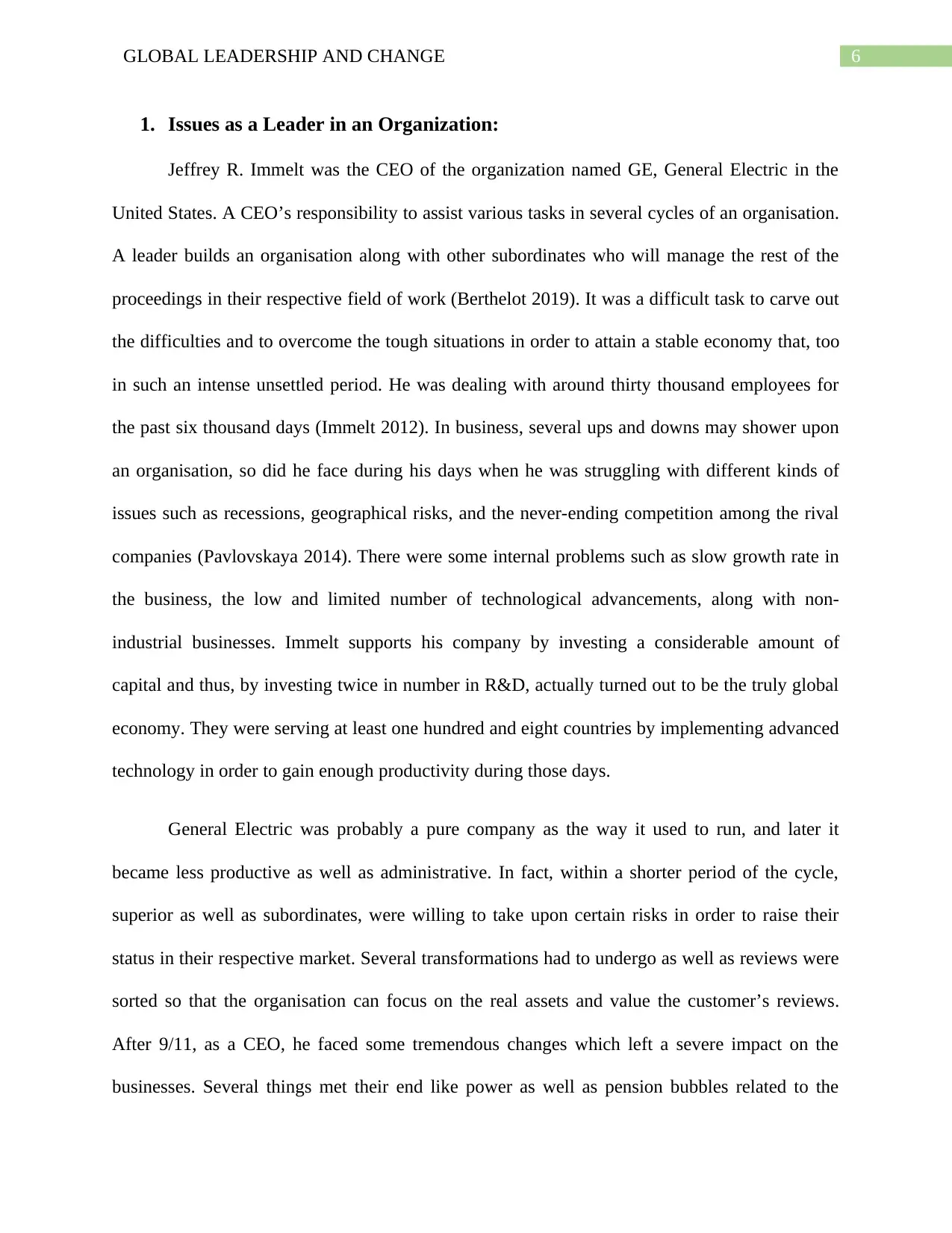
6GLOBAL LEADERSHIP AND CHANGE
1. Issues as a Leader in an Organization:
Jeffrey R. Immelt was the CEO of the organization named GE, General Electric in the
United States. A CEO’s responsibility to assist various tasks in several cycles of an organisation.
A leader builds an organisation along with other subordinates who will manage the rest of the
proceedings in their respective field of work (Berthelot 2019). It was a difficult task to carve out
the difficulties and to overcome the tough situations in order to attain a stable economy that, too
in such an intense unsettled period. He was dealing with around thirty thousand employees for
the past six thousand days (Immelt 2012). In business, several ups and downs may shower upon
an organisation, so did he face during his days when he was struggling with different kinds of
issues such as recessions, geographical risks, and the never-ending competition among the rival
companies (Pavlovskaya 2014). There were some internal problems such as slow growth rate in
the business, the low and limited number of technological advancements, along with non-
industrial businesses. Immelt supports his company by investing a considerable amount of
capital and thus, by investing twice in number in R&D, actually turned out to be the truly global
economy. They were serving at least one hundred and eight countries by implementing advanced
technology in order to gain enough productivity during those days.
General Electric was probably a pure company as the way it used to run, and later it
became less productive as well as administrative. In fact, within a shorter period of the cycle,
superior as well as subordinates, were willing to take upon certain risks in order to raise their
status in their respective market. Several transformations had to undergo as well as reviews were
sorted so that the organisation can focus on the real assets and value the customer’s reviews.
After 9/11, as a CEO, he faced some tremendous changes which left a severe impact on the
businesses. Several things met their end like power as well as pension bubbles related to the
1. Issues as a Leader in an Organization:
Jeffrey R. Immelt was the CEO of the organization named GE, General Electric in the
United States. A CEO’s responsibility to assist various tasks in several cycles of an organisation.
A leader builds an organisation along with other subordinates who will manage the rest of the
proceedings in their respective field of work (Berthelot 2019). It was a difficult task to carve out
the difficulties and to overcome the tough situations in order to attain a stable economy that, too
in such an intense unsettled period. He was dealing with around thirty thousand employees for
the past six thousand days (Immelt 2012). In business, several ups and downs may shower upon
an organisation, so did he face during his days when he was struggling with different kinds of
issues such as recessions, geographical risks, and the never-ending competition among the rival
companies (Pavlovskaya 2014). There were some internal problems such as slow growth rate in
the business, the low and limited number of technological advancements, along with non-
industrial businesses. Immelt supports his company by investing a considerable amount of
capital and thus, by investing twice in number in R&D, actually turned out to be the truly global
economy. They were serving at least one hundred and eight countries by implementing advanced
technology in order to gain enough productivity during those days.
General Electric was probably a pure company as the way it used to run, and later it
became less productive as well as administrative. In fact, within a shorter period of the cycle,
superior as well as subordinates, were willing to take upon certain risks in order to raise their
status in their respective market. Several transformations had to undergo as well as reviews were
sorted so that the organisation can focus on the real assets and value the customer’s reviews.
After 9/11, as a CEO, he faced some tremendous changes which left a severe impact on the
businesses. Several things met their end like power as well as pension bubbles related to the
Paraphrase This Document
Need a fresh take? Get an instant paraphrase of this document with our AI Paraphraser
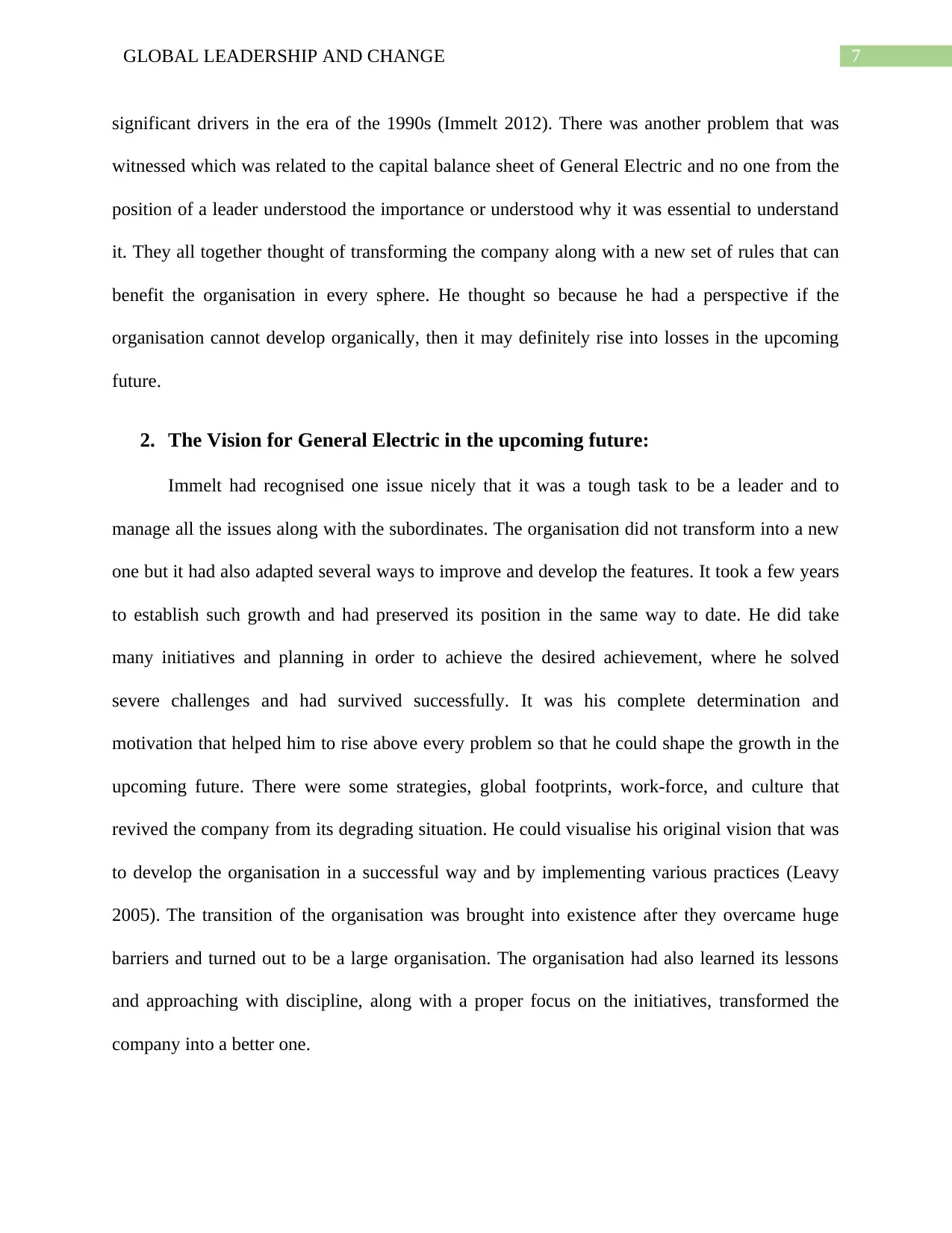
7GLOBAL LEADERSHIP AND CHANGE
significant drivers in the era of the 1990s (Immelt 2012). There was another problem that was
witnessed which was related to the capital balance sheet of General Electric and no one from the
position of a leader understood the importance or understood why it was essential to understand
it. They all together thought of transforming the company along with a new set of rules that can
benefit the organisation in every sphere. He thought so because he had a perspective if the
organisation cannot develop organically, then it may definitely rise into losses in the upcoming
future.
2. The Vision for General Electric in the upcoming future:
Immelt had recognised one issue nicely that it was a tough task to be a leader and to
manage all the issues along with the subordinates. The organisation did not transform into a new
one but it had also adapted several ways to improve and develop the features. It took a few years
to establish such growth and had preserved its position in the same way to date. He did take
many initiatives and planning in order to achieve the desired achievement, where he solved
severe challenges and had survived successfully. It was his complete determination and
motivation that helped him to rise above every problem so that he could shape the growth in the
upcoming future. There were some strategies, global footprints, work-force, and culture that
revived the company from its degrading situation. He could visualise his original vision that was
to develop the organisation in a successful way and by implementing various practices (Leavy
2005). The transition of the organisation was brought into existence after they overcame huge
barriers and turned out to be a large organisation. The organisation had also learned its lessons
and approaching with discipline, along with a proper focus on the initiatives, transformed the
company into a better one.
significant drivers in the era of the 1990s (Immelt 2012). There was another problem that was
witnessed which was related to the capital balance sheet of General Electric and no one from the
position of a leader understood the importance or understood why it was essential to understand
it. They all together thought of transforming the company along with a new set of rules that can
benefit the organisation in every sphere. He thought so because he had a perspective if the
organisation cannot develop organically, then it may definitely rise into losses in the upcoming
future.
2. The Vision for General Electric in the upcoming future:
Immelt had recognised one issue nicely that it was a tough task to be a leader and to
manage all the issues along with the subordinates. The organisation did not transform into a new
one but it had also adapted several ways to improve and develop the features. It took a few years
to establish such growth and had preserved its position in the same way to date. He did take
many initiatives and planning in order to achieve the desired achievement, where he solved
severe challenges and had survived successfully. It was his complete determination and
motivation that helped him to rise above every problem so that he could shape the growth in the
upcoming future. There were some strategies, global footprints, work-force, and culture that
revived the company from its degrading situation. He could visualise his original vision that was
to develop the organisation in a successful way and by implementing various practices (Leavy
2005). The transition of the organisation was brought into existence after they overcame huge
barriers and turned out to be a large organisation. The organisation had also learned its lessons
and approaching with discipline, along with a proper focus on the initiatives, transformed the
company into a better one.
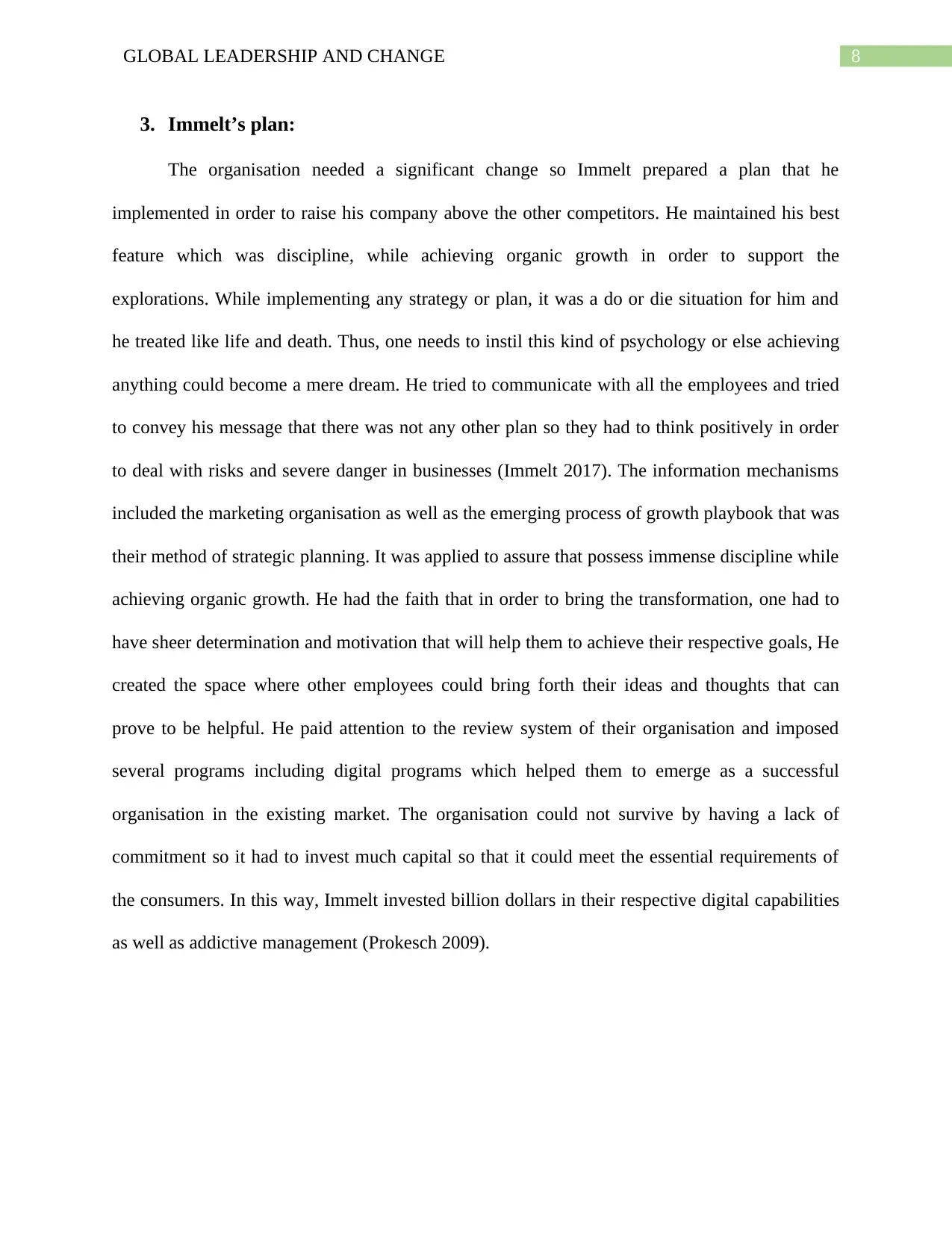
8GLOBAL LEADERSHIP AND CHANGE
3. Immelt’s plan:
The organisation needed a significant change so Immelt prepared a plan that he
implemented in order to raise his company above the other competitors. He maintained his best
feature which was discipline, while achieving organic growth in order to support the
explorations. While implementing any strategy or plan, it was a do or die situation for him and
he treated like life and death. Thus, one needs to instil this kind of psychology or else achieving
anything could become a mere dream. He tried to communicate with all the employees and tried
to convey his message that there was not any other plan so they had to think positively in order
to deal with risks and severe danger in businesses (Immelt 2017). The information mechanisms
included the marketing organisation as well as the emerging process of growth playbook that was
their method of strategic planning. It was applied to assure that possess immense discipline while
achieving organic growth. He had the faith that in order to bring the transformation, one had to
have sheer determination and motivation that will help them to achieve their respective goals, He
created the space where other employees could bring forth their ideas and thoughts that can
prove to be helpful. He paid attention to the review system of their organisation and imposed
several programs including digital programs which helped them to emerge as a successful
organisation in the existing market. The organisation could not survive by having a lack of
commitment so it had to invest much capital so that it could meet the essential requirements of
the consumers. In this way, Immelt invested billion dollars in their respective digital capabilities
as well as addictive management (Prokesch 2009).
3. Immelt’s plan:
The organisation needed a significant change so Immelt prepared a plan that he
implemented in order to raise his company above the other competitors. He maintained his best
feature which was discipline, while achieving organic growth in order to support the
explorations. While implementing any strategy or plan, it was a do or die situation for him and
he treated like life and death. Thus, one needs to instil this kind of psychology or else achieving
anything could become a mere dream. He tried to communicate with all the employees and tried
to convey his message that there was not any other plan so they had to think positively in order
to deal with risks and severe danger in businesses (Immelt 2017). The information mechanisms
included the marketing organisation as well as the emerging process of growth playbook that was
their method of strategic planning. It was applied to assure that possess immense discipline while
achieving organic growth. He had the faith that in order to bring the transformation, one had to
have sheer determination and motivation that will help them to achieve their respective goals, He
created the space where other employees could bring forth their ideas and thoughts that can
prove to be helpful. He paid attention to the review system of their organisation and imposed
several programs including digital programs which helped them to emerge as a successful
organisation in the existing market. The organisation could not survive by having a lack of
commitment so it had to invest much capital so that it could meet the essential requirements of
the consumers. In this way, Immelt invested billion dollars in their respective digital capabilities
as well as addictive management (Prokesch 2009).
⊘ This is a preview!⊘
Do you want full access?
Subscribe today to unlock all pages.

Trusted by 1+ million students worldwide
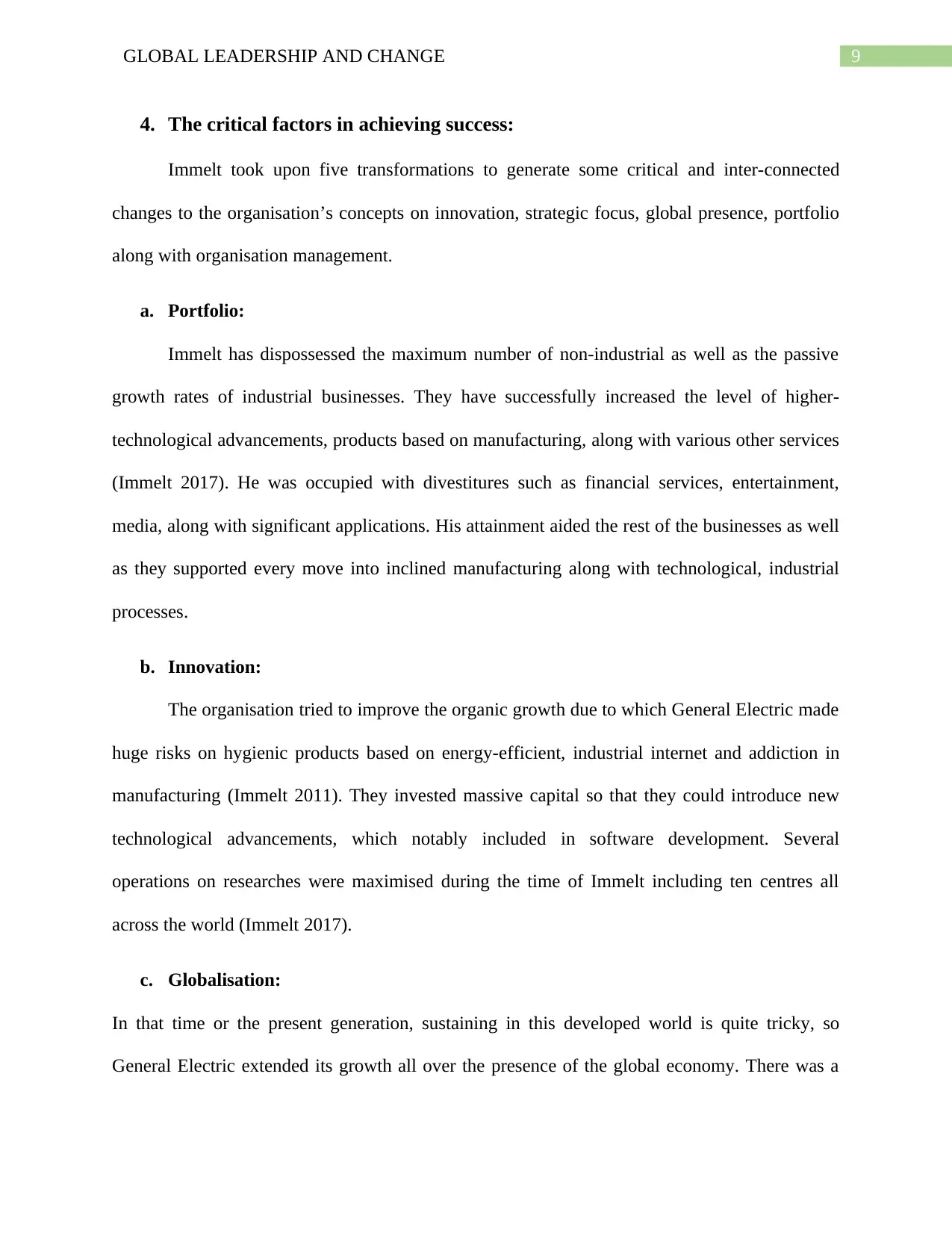
9GLOBAL LEADERSHIP AND CHANGE
4. The critical factors in achieving success:
Immelt took upon five transformations to generate some critical and inter-connected
changes to the organisation’s concepts on innovation, strategic focus, global presence, portfolio
along with organisation management.
a. Portfolio:
Immelt has dispossessed the maximum number of non-industrial as well as the passive
growth rates of industrial businesses. They have successfully increased the level of higher-
technological advancements, products based on manufacturing, along with various other services
(Immelt 2017). He was occupied with divestitures such as financial services, entertainment,
media, along with significant applications. His attainment aided the rest of the businesses as well
as they supported every move into inclined manufacturing along with technological, industrial
processes.
b. Innovation:
The organisation tried to improve the organic growth due to which General Electric made
huge risks on hygienic products based on energy-efficient, industrial internet and addiction in
manufacturing (Immelt 2011). They invested massive capital so that they could introduce new
technological advancements, which notably included in software development. Several
operations on researches were maximised during the time of Immelt including ten centres all
across the world (Immelt 2017).
c. Globalisation:
In that time or the present generation, sustaining in this developed world is quite tricky, so
General Electric extended its growth all over the presence of the global economy. There was a
4. The critical factors in achieving success:
Immelt took upon five transformations to generate some critical and inter-connected
changes to the organisation’s concepts on innovation, strategic focus, global presence, portfolio
along with organisation management.
a. Portfolio:
Immelt has dispossessed the maximum number of non-industrial as well as the passive
growth rates of industrial businesses. They have successfully increased the level of higher-
technological advancements, products based on manufacturing, along with various other services
(Immelt 2017). He was occupied with divestitures such as financial services, entertainment,
media, along with significant applications. His attainment aided the rest of the businesses as well
as they supported every move into inclined manufacturing along with technological, industrial
processes.
b. Innovation:
The organisation tried to improve the organic growth due to which General Electric made
huge risks on hygienic products based on energy-efficient, industrial internet and addiction in
manufacturing (Immelt 2011). They invested massive capital so that they could introduce new
technological advancements, which notably included in software development. Several
operations on researches were maximised during the time of Immelt including ten centres all
across the world (Immelt 2017).
c. Globalisation:
In that time or the present generation, sustaining in this developed world is quite tricky, so
General Electric extended its growth all over the presence of the global economy. There was a
Paraphrase This Document
Need a fresh take? Get an instant paraphrase of this document with our AI Paraphraser
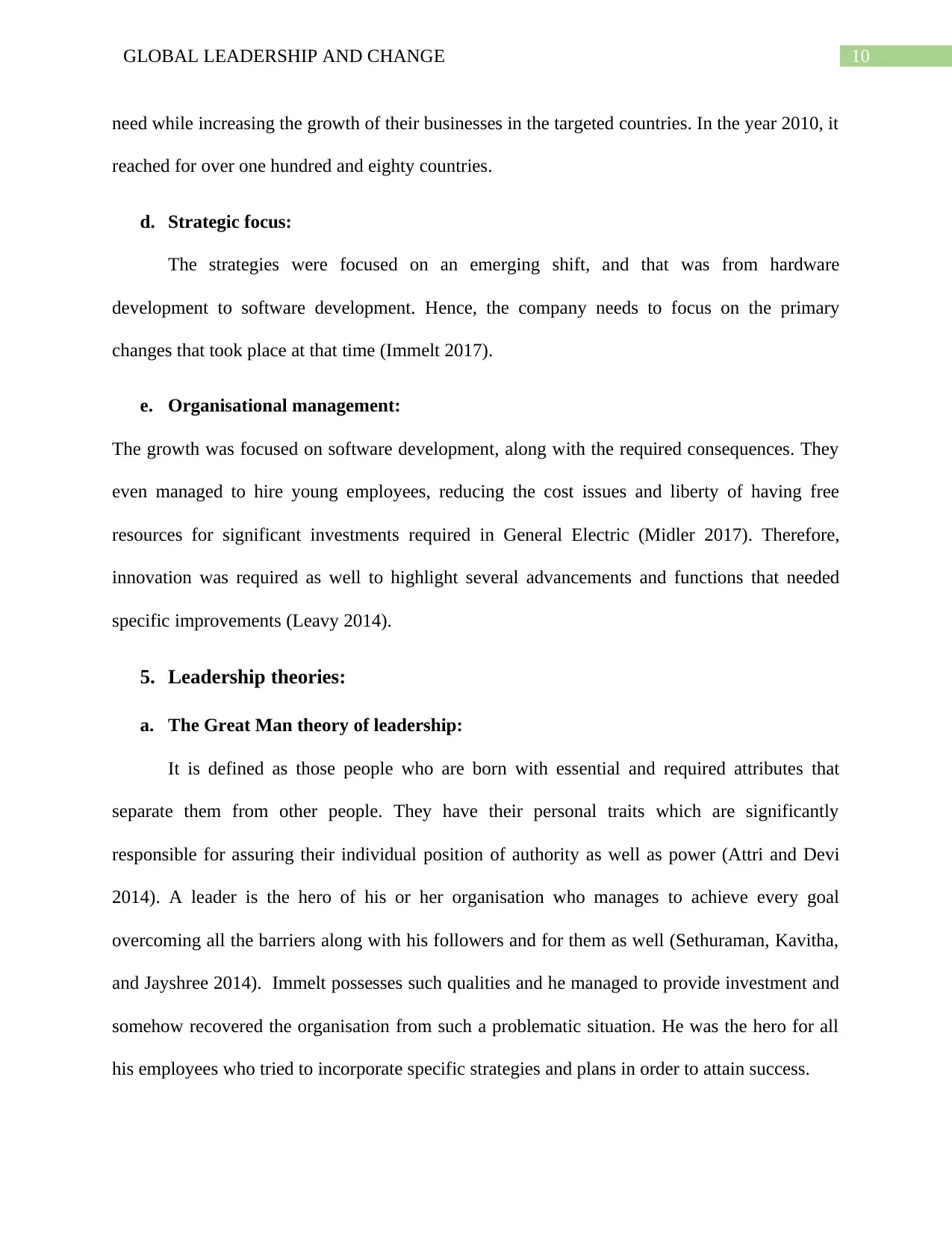
10GLOBAL LEADERSHIP AND CHANGE
need while increasing the growth of their businesses in the targeted countries. In the year 2010, it
reached for over one hundred and eighty countries.
d. Strategic focus:
The strategies were focused on an emerging shift, and that was from hardware
development to software development. Hence, the company needs to focus on the primary
changes that took place at that time (Immelt 2017).
e. Organisational management:
The growth was focused on software development, along with the required consequences. They
even managed to hire young employees, reducing the cost issues and liberty of having free
resources for significant investments required in General Electric (Midler 2017). Therefore,
innovation was required as well to highlight several advancements and functions that needed
specific improvements (Leavy 2014).
5. Leadership theories:
a. The Great Man theory of leadership:
It is defined as those people who are born with essential and required attributes that
separate them from other people. They have their personal traits which are significantly
responsible for assuring their individual position of authority as well as power (Attri and Devi
2014). A leader is the hero of his or her organisation who manages to achieve every goal
overcoming all the barriers along with his followers and for them as well (Sethuraman, Kavitha,
and Jayshree 2014). Immelt possesses such qualities and he managed to provide investment and
somehow recovered the organisation from such a problematic situation. He was the hero for all
his employees who tried to incorporate specific strategies and plans in order to attain success.
need while increasing the growth of their businesses in the targeted countries. In the year 2010, it
reached for over one hundred and eighty countries.
d. Strategic focus:
The strategies were focused on an emerging shift, and that was from hardware
development to software development. Hence, the company needs to focus on the primary
changes that took place at that time (Immelt 2017).
e. Organisational management:
The growth was focused on software development, along with the required consequences. They
even managed to hire young employees, reducing the cost issues and liberty of having free
resources for significant investments required in General Electric (Midler 2017). Therefore,
innovation was required as well to highlight several advancements and functions that needed
specific improvements (Leavy 2014).
5. Leadership theories:
a. The Great Man theory of leadership:
It is defined as those people who are born with essential and required attributes that
separate them from other people. They have their personal traits which are significantly
responsible for assuring their individual position of authority as well as power (Attri and Devi
2014). A leader is the hero of his or her organisation who manages to achieve every goal
overcoming all the barriers along with his followers and for them as well (Sethuraman, Kavitha,
and Jayshree 2014). Immelt possesses such qualities and he managed to provide investment and
somehow recovered the organisation from such a problematic situation. He was the hero for all
his employees who tried to incorporate specific strategies and plans in order to attain success.
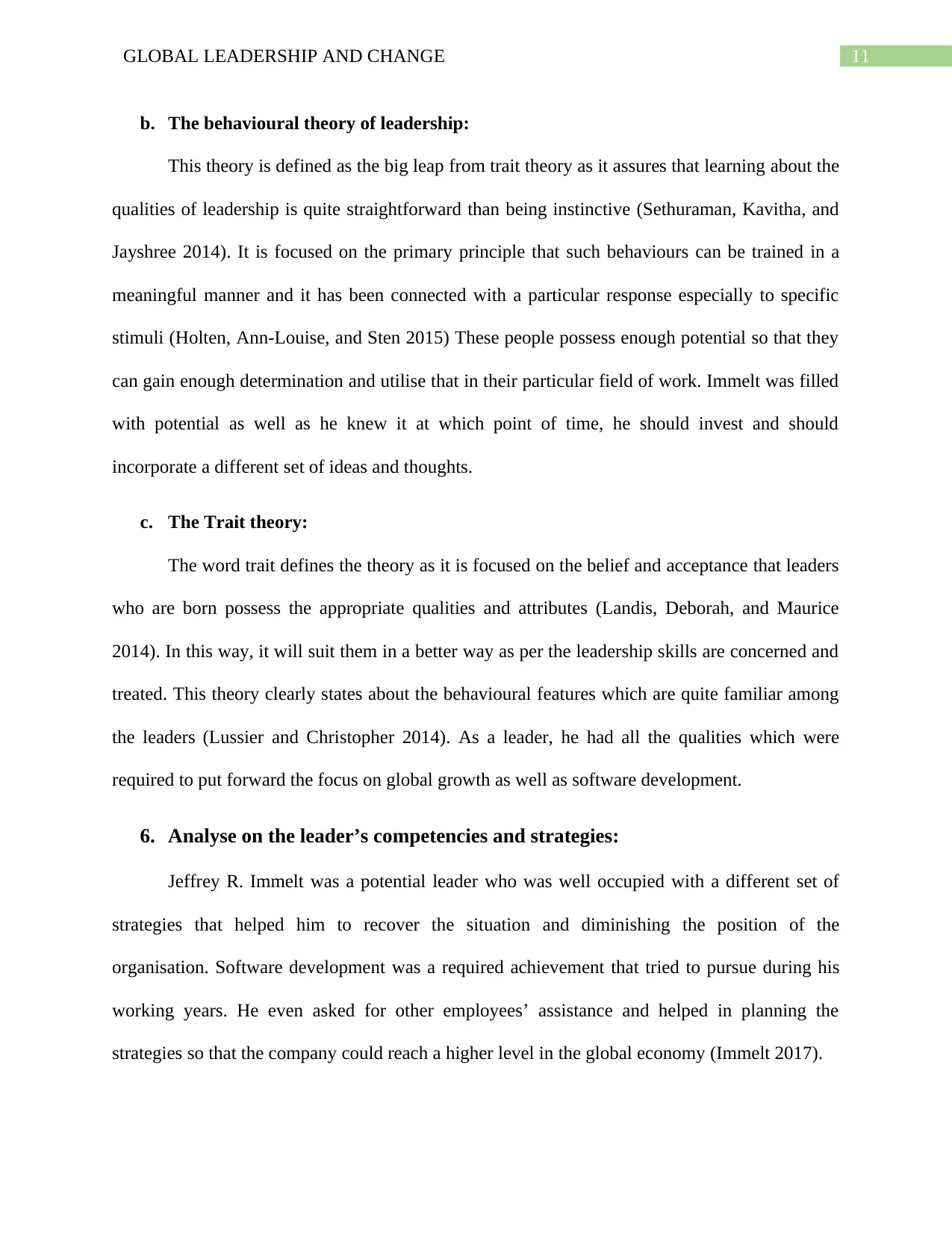
11GLOBAL LEADERSHIP AND CHANGE
b. The behavioural theory of leadership:
This theory is defined as the big leap from trait theory as it assures that learning about the
qualities of leadership is quite straightforward than being instinctive (Sethuraman, Kavitha, and
Jayshree 2014). It is focused on the primary principle that such behaviours can be trained in a
meaningful manner and it has been connected with a particular response especially to specific
stimuli (Holten, Ann-Louise, and Sten 2015) These people possess enough potential so that they
can gain enough determination and utilise that in their particular field of work. Immelt was filled
with potential as well as he knew it at which point of time, he should invest and should
incorporate a different set of ideas and thoughts.
c. The Trait theory:
The word trait defines the theory as it is focused on the belief and acceptance that leaders
who are born possess the appropriate qualities and attributes (Landis, Deborah, and Maurice
2014). In this way, it will suit them in a better way as per the leadership skills are concerned and
treated. This theory clearly states about the behavioural features which are quite familiar among
the leaders (Lussier and Christopher 2014). As a leader, he had all the qualities which were
required to put forward the focus on global growth as well as software development.
6. Analyse on the leader’s competencies and strategies:
Jeffrey R. Immelt was a potential leader who was well occupied with a different set of
strategies that helped him to recover the situation and diminishing the position of the
organisation. Software development was a required achievement that tried to pursue during his
working years. He even asked for other employees’ assistance and helped in planning the
strategies so that the company could reach a higher level in the global economy (Immelt 2017).
b. The behavioural theory of leadership:
This theory is defined as the big leap from trait theory as it assures that learning about the
qualities of leadership is quite straightforward than being instinctive (Sethuraman, Kavitha, and
Jayshree 2014). It is focused on the primary principle that such behaviours can be trained in a
meaningful manner and it has been connected with a particular response especially to specific
stimuli (Holten, Ann-Louise, and Sten 2015) These people possess enough potential so that they
can gain enough determination and utilise that in their particular field of work. Immelt was filled
with potential as well as he knew it at which point of time, he should invest and should
incorporate a different set of ideas and thoughts.
c. The Trait theory:
The word trait defines the theory as it is focused on the belief and acceptance that leaders
who are born possess the appropriate qualities and attributes (Landis, Deborah, and Maurice
2014). In this way, it will suit them in a better way as per the leadership skills are concerned and
treated. This theory clearly states about the behavioural features which are quite familiar among
the leaders (Lussier and Christopher 2014). As a leader, he had all the qualities which were
required to put forward the focus on global growth as well as software development.
6. Analyse on the leader’s competencies and strategies:
Jeffrey R. Immelt was a potential leader who was well occupied with a different set of
strategies that helped him to recover the situation and diminishing the position of the
organisation. Software development was a required achievement that tried to pursue during his
working years. He even asked for other employees’ assistance and helped in planning the
strategies so that the company could reach a higher level in the global economy (Immelt 2017).
⊘ This is a preview!⊘
Do you want full access?
Subscribe today to unlock all pages.

Trusted by 1+ million students worldwide
1 out of 16
Related Documents
Your All-in-One AI-Powered Toolkit for Academic Success.
+13062052269
info@desklib.com
Available 24*7 on WhatsApp / Email
![[object Object]](/_next/static/media/star-bottom.7253800d.svg)
Unlock your academic potential
Copyright © 2020–2025 A2Z Services. All Rights Reserved. Developed and managed by ZUCOL.





